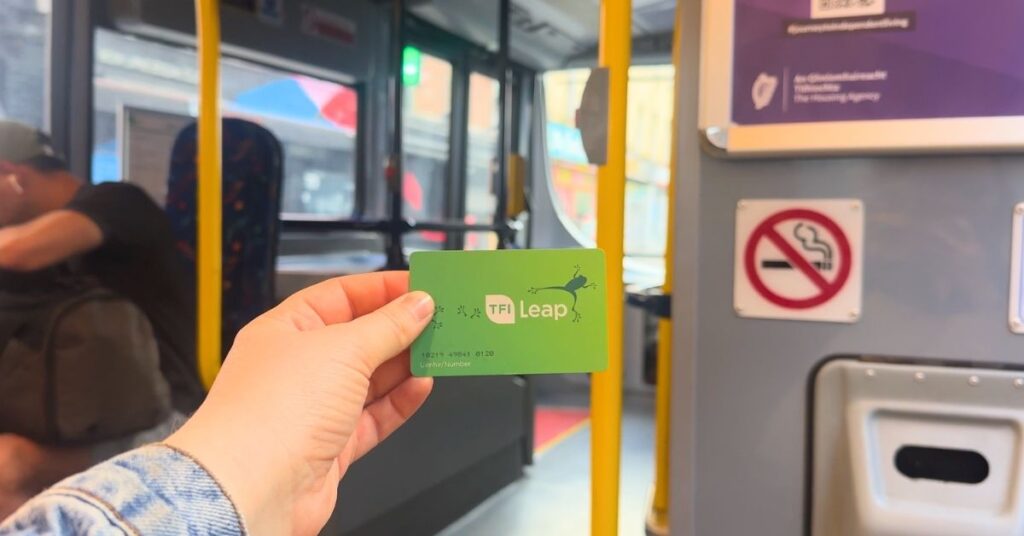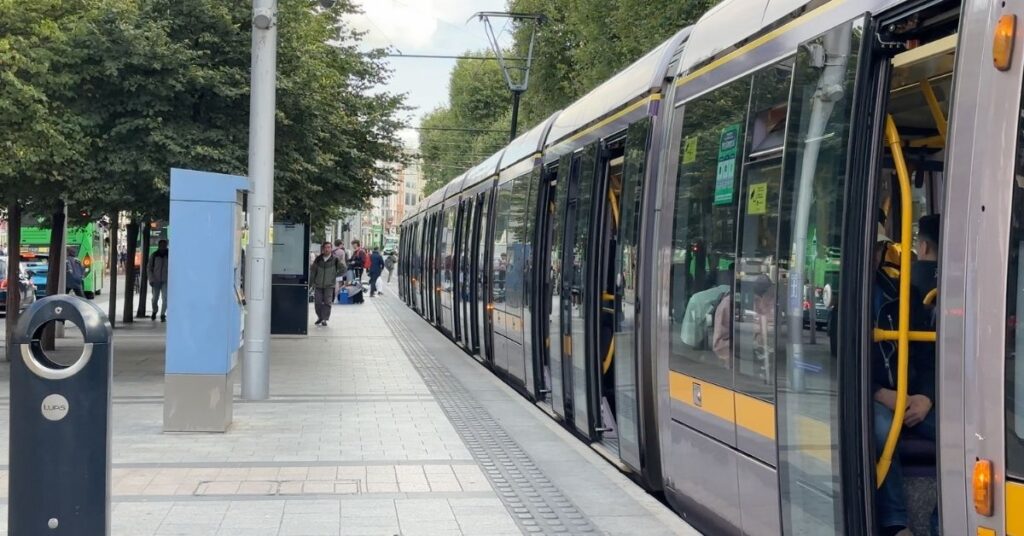❌ Avoid Mistakes Visitors Make on Public Transport in Dublin – with this Locals Guide
Ireland Travel Planning contains affiliate links and is a member of the Amazon Services LLC Associates Program. If you make a purchase using one of these links, I may receive compensation at no extra cost to you. See my Disclosure Policy for more information. Ireland Travel Planning also uses both personal and paid stock photos to illustate posts
Visiting Dublin for the first time can be a bit confusing when it comes to public transport. But don’t worry – this guide will break down everything you need to know about getting around the city like a local.
Public Transport Options in Dublin
There are three main types of public transport in Dublin: the DART, the LUAS, and Dublin Bus.
- The DART is a train system that connects the city with coastal areas such as Howth, Dun Laoghaire, and Bray. These towns are popular for day trips, and the DART is the most convenient way to reach them.
- Dublin Bus is the city’s primary public transport service, offering routes to most tourist attractions and suburban areas. Whether you’re staying in the heart of the city or exploring beyond, there are plenty of routes to choose from.
- The LUAS is Dublin’s tram system, a great alternative to an underground subway. It has two lines – the Red and the Green – which service key points in the city and extend into some suburban areas.
Before you visit Ireland, here's some quick recommendations…
📞 International roaming can be expensive, honestly eSims are the way to go! Airalo offers some pretty affordable cell phone plans that work seamlessly across Ireland, this one is best for travel within the Republic of Ireland and these deals work in both the Republic and Northern Ireland.
🏨 Hotel prices can go up and down, I always like to compare pricing by using site such as Booking.com or Hotels.com
🚌 Actives and Experiences is what makes an Ireland trip that extra bit special! Like did you know you can design your own Claddagh Ring? (one of my favourites). I typically find the best experiences by using the likes of GetYourGuide or Viator.
🚘 Renting a car is one of the best ways to explore the beauty of Ireland, but the pricing can be very competitive, that's why it is always best to check out site like Discover Cars to compare rental prices.
✈️ You never know what airlines may be offering Ireland flight deals, they can go down by 100's in a day, I always like to turn on price tracker on Skyscanner so I never miss a deal!
🏥 I can't stress this enough but travel insurance is an absolute must! Thankfully SafetyWing have some pretty affordable plans.

LEAP Card: Your Key to Easy Travel
Before diving into how to use each mode of transport, let’s talk about the LEAP Card, a handy smart card that works across all three transport types.
The LEAP Card can be used not just in Dublin but in many major cities and towns across Ireland. For visitors, getting a LEAP Card is highly recommended as it simplifies the process of navigating public transport.
- Where to Get a LEAP Card: The easiest way to get one is by purchasing it at kiosks found in small corner shops like SPAR or Centra. Most stores have a sign outside indicating they sell LEAP Cards, and there’s a map on the LEAP website showing all locations.
- Cost and Top-Up Options: A LEAP Card costs €5, and I suggest topping it up with €10 or €20, depending on how long you’ll be in the city. You can also order a LEAP Card online ahead of time and have it delivered, which saves you the hassle of finding one when you arrive.
- Topping Up On the Go: If you find yourself running low on credit, you can download the LEAP app and top up your card using your phone.
Benefits of Using the LEAP Card
One of the biggest advantages of the LEAP Card is that it allows for contactless payments. You won’t need to worry about purchasing individual tickets each time you ride.
- Fare Caps: LEAP users benefit from fare caps. For example, the most an adult can pay in a single day is €8. After that, any additional journeys are free (I'll explain a little more about this in the below section)
- 90-Minute Travel Window: With the LEAP Card, you can travel across as many Dublin Buses, LUAS trams, or DART trains as you like within a 90-minute period for just €2.
- Tourist LEAP Card: For visitors, there is also a Tourist LEAP Card available. It offers unlimited travel for a set fee, but I struggle to see where this pass actually values the visitor as the normal leap card is capped at €32 anyways and you may not end up paying that much.
How the capped system works:
- Daily Caps: Start at 4:30 AM and reset at 4:29 AM the next day.
- Weekly Caps: Run from 4:30 AM on Monday to 4:29 AM the following Monday. Any amounts spent do not carry over after the reset. Even after hitting the cap, continue to touch on and off as usual to ensure your trips are registered—but you won’t be charged further travel credit.
- TFI 90 Minute Fare: Lets you travel across multiple Dublin transport services (bus, LUAS & most DART routes) for up to 90 minutes at a single flat fare with fares for Adults being €2, Young Adults (19–25)/Students €1 and Children €0.65.
Fare Caps (At the time of writing November 2024):
| Service | Passenger Type | Daily Cap | Weekly Cap (Mon-Sun) |
|---|---|---|---|
| Dublin City Bus | Adult | €5.60 | €22.00 |
| Young Adult/Student | €2.80 | €11.00 | |
| Child | €2.10 | €6.80 | |
| Luas | Adult | €5.60 | €22.00 |
| Young Adult/Student | €2.80 | €11.00 | |
| Child | €2.10 | €6.80 | |
| DART | Adult | €7.60 | €29.60 |
| Young Adult/Student | €3.80 | €14.80 | |
| Child | €2.50 | €10.00 | |
| Multi-Services | Adult | €8.00 | €32.00 |
| Young Adult/Student | €4.00 | €16.00 | |
| Child | €2.80 | €11.20 |
Need with your Ireland trip? Let me be your guide…
🙋♀️ Travel Consultation
Book a 40 minute Ireland Travel Planning call with Laura your local guide to discuss some insider tips for your Ireland vacation!
🇮🇪 Free Resources
Explore my free resources packed with insider tips and expert knowledge to help you plan your trip to Ireland!
😘 Say Thank You
Finding my content helpful? A small tip would mean the world to me. It helps me to continue making these free guides 💛
Or, Join my FREE Ireland Travel Planning Facebook Group to ask questions about your upcoming trip! I pop in once a week to answer as manny as possible 🇮🇪
Need with your Ireland trip? Let me be your guide…
🙋♀️ Travel Consultation: Book a 40 minute Ireland Travel Planning call with Laura your local guide to discuss some insider tips for your Ireland vacation!
🇮🇪 Free Resources: Explore my free resources packed with insider tips and expert knowledge to help you plan your trip to Ireland!
😘 Say Thank You: Finding my content helpful? A small tip would mean the world to me. It helps me to continue making these free guides 💛
ℹ️ Join my FREE Ireland Travel Planning Facebook Group to ask questions about your upcoming trip! I pop in once a week to answer as manny as possible 🇮🇪

Using the DART
The DART serves Dublin’s coastal areas. It’s easy to use, with a few ticketing options:
- Tickets: You can buy tickets at self-service machines or ticket offices in larger stations. The machines accept both cash and card, and you’ll be prompted to select your ticket type (adult, child, return, single, and your destination).
- Using the LEAP Card: If you’re using a LEAP Card, simply scan it at the barriers when entering and exiting the platforms. Even if the barriers are up, be sure to scan to avoid being overcharged.
- Finding Your Train: In larger stations like Connolly, a screen will display which platform your DART is leaving from. Once on board, seats are unassigned, and each stop is announced in both English and Irish.

Riding the Dublin Bus
Dublin Bus operates throughout the city, but there are a few key things to know before hopping on.
- Flagging the Bus: Simply standing at the bus stop won’t stop the bus. You’ll need to flag it down by putting your hand out as it approaches, or it will drive right past you!
- Digital Displays: Some bus stops have digital displays showing when the next bus will arrive. These can be handy but aren’t always accurate. Buses sometimes disappear from the display entirely, so use them with a grain of salt.
- Paying for the Bus: You can either pay with exact change in coins (no notes or change given) or use your LEAP Card. There are two LEAP scanners – one by the driver, which is ideal for short trips, and one inside the bus for general use. If you scan with the driver, you’ll pay a lower fare for shorter journeys.
- Getting Off the Bus: Stops are announced in both English and Irish. When you want to get off, press the red stop button, and the bus will pull over at the next stop. Most passengers exit through the back door, and it’s common to thank the driver as you leave.

Navigating the LUAS
The LUAS is a quick and convenient way to get around Dublin, especially during busy periods.
- Tickets and Payments: Like the DART, the LUAS has self-service ticket machines that accept cash and card payments. You can also top up your LEAP Card at these machines.
- Using the LEAP Card: Tap your LEAP Card at the validator on the platform before boarding and again when you exit. If your journey costs less than €2 and you forget to tap off, you’ll be charged the full fare.
- Finding Your Stop: Each stop is announced in both English and Irish and displayed on a screen inside the tram. There’s a route map above the doors, which is handy for ensuring you’re headed in the right direction.
Other Transport Options in Dublin
- Taxis: Taxis in Dublin can be expensive, but they’re sometimes necessary. To hail a taxi, you’ll need to put your arm out. If the taxi light is off, it’s already in service. You can also use the FREE NOW app, which is the safest and most popular way to book a taxi in Dublin. All taxis are required to accept card payments.
- Dublin Bikes: With over 100 stations around the city, Dublin Bikes offers 30-minute rides for free, making it an affordable and quick way to get around. Everything is operated through a designated app.
- Walking: While walking isn’t a transport option in the traditional sense, Dublin is a very walkable city. Most major attractions can be reached on foot within 20 to 30 minutes, and you never know what hidden gems you’ll discover along the way.
Day Trip Options
For those wanting to take day trips outside of Dublin, there are two public transport options: Bus Éireann and Irish Rail. Bus Éireann departs from Busáras Station, while Irish Rail services leave from Connolly Station.
However, if you’re short on time, organized tours may be a better option for visiting places like the Cliffs of Moher, Giant’s Causeway, or Wicklow National Park. I’ve linked some of the top tours below.
Practical Tips for Using Public Transport in Dublin
- Escalators: In Ireland, people don’t typically stand to one side on escalators. If you’re in a rush, don’t hesitate to ask the person in front to move.
- Google Maps: Google Maps is an excellent tool for checking routes and transport times. Recently, live bus tracking has been added to some routes, which can be very useful.
- Rush Hour: Be aware of rush hour in Dublin, which usually runs from 8:30 AM to 9:30 AM and 5 PM to 7 PM. During these times, buses may be full, and LUAS or DART services can get crowded.
- Operation Hours: Public transport in Dublin typically starts around 5 AM and runs until midnight. A few 24-hour buses are available, but most lines shut down late at night.
- Accessibility: Both LUAS lines are wheelchair accessible, and Dublin Bus has wheelchair ramps, with drivers assisting as needed. For DART services, station accessibility can vary, so it's best to check the Irish Rail website ahead of time.
Have a Ireland Travel Question?
Then join my FREE Facebook Community, I pop in once a week to answer as many queries as possible. Please do not email or DM. It is easier for me to manage everything in the one place 😊
👋 JOIN MY FREE IRELAND FACEBOOK COMMUNITY

🇮🇪🇮🇪🇮🇪
FREE IRELAND FACEBOOK COMMUNITY
✔️ LOCAL ADVICE
✔️ FREE ACCESS TO GOOGLE MAPS PINS
✔️ GROUP DISCUSSION







